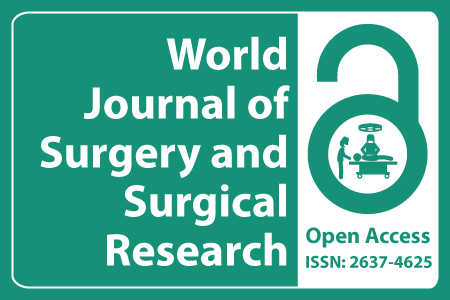
Journal Basic Info
- Impact Factor: 1.989**
- H-Index: 6
- ISSN: 2637-4625
- DOI: 10.25107/2637-4625
Major Scope
- Oral & Maxillofacial Surgery
- Bariatric Surgery
- Breast Surgery
- General Surgery
- Anesthesiology
- Pediatric Surgery
- Laparoscopic Surgery
- Surgery & Surgical Research
Abstract
Citation: World J Surg Surg Res. 2018;1(1):1067.DOI: 10.25107/2637-4625.1067
Intracorporeal Autologous Hepatocyte Matrix Implant for the Treatment of Chronic Liver Disease: A Modified Clinical Phase I Study
Hans U. Baer, Siufui Hendrawan, Suryadi The, Syafruddin AR. Lelosutan, Salim G, Toni Lindl, Stephanie Mathes, Ursula Graf-Hausner, Ursula Weber, Randall Watson and Barlian Sutedja
Center of Abdominal Surgery, Hirslanden Clinic, University of Bern, Switzerland
Tarumanagara Human Cell Technology Laboratory, Tarumanagara University, School of Medicine, Indonesia
Department of Surgery, Gading Pluit Hospital, Indonesia
Department of Internal Medicine, Gading Pluit Hospital, Indonesia
IAZ - Institute for Applied Cell Culture, Germany
University of Zurich, Center of Dental Medicine, Switzerland
Zurich University of Applied Sciences, Tissue Engineering/Drug Development (TEDD), Switzerland
Medical Writer, Limmatstrasse, Switzerland
*Correspondance to: Hans U. Baer
PDF Full Text Research Article | Open Access
Abstract:
Background and
Aim: Cultured human autologous hepatocyte matrix implants have been used to treat chronic liver cirrhosis with some success and are a promising method to counter liver damage. The options afforded by hepatocyte transplant are of special importance as this may prolong or improve the lives of patients waiting for a transplant. We assessed the safety of implanted scaffold cultured hepatocytes upon patient survival in a modified phase 1 trial.
Methods: We present here the first ethically approved in human study of autologous hepatocyte matrix implantation for the treatment of predominantly viral hepatitis induced cirrhosis. The study was performed in patients with longstanding liver disease at a single center in Jakarta, Indonesia. Liver segments and pancreatic tissue from each patient were taken and processed to single hepatocytes and islets of Langerhans, respectively. The single cells were co-seeded onto PLA scaffolds, cultured, and transplanted back into the patient. We performed pre-implantation diagnosis and measured clinical disease severity scores (CTP and MELD) and liver function (albumin, bilirubin, ammonia, cholinesterase levels). In our small cohort, the procedure was generally safe.
Results: The small patient number prevented any statistical assessment of efficacy. For some patients we observed clinically relevant improvements of liver function. Some patients showed improvements in stamina, endurance to physical stress, reduced frequency of hospitalization and incidence of encephalopathy, GI bleeding, ascites, and esophageal varices.
Conclusion: Although limited in power for statistical significance, the present work presents sufficient data to warrant pursuing a phase 2 follow-up study.
Keywords:
Chronic liver disease; Autologous hepatocyte matrix implant; PLLA matrix
Cite the Article:
Baer HU, Hendrawan S, The S, Lelosutan SAR, Salim G, Lindl T, et al. Intracorporeal Autologous Hepatocyte Matrix Implant for the Treatment of Chronic Liver Disease: A Modified Clinical Phase I Study. World J Surg Surgical Res. 2018; 1: 1067.













